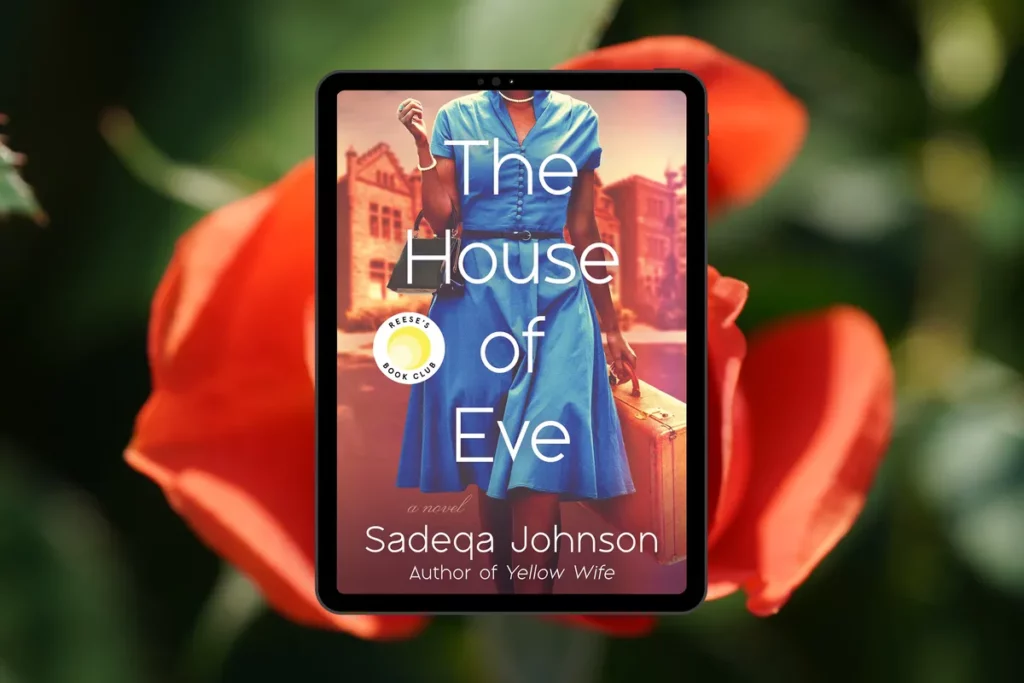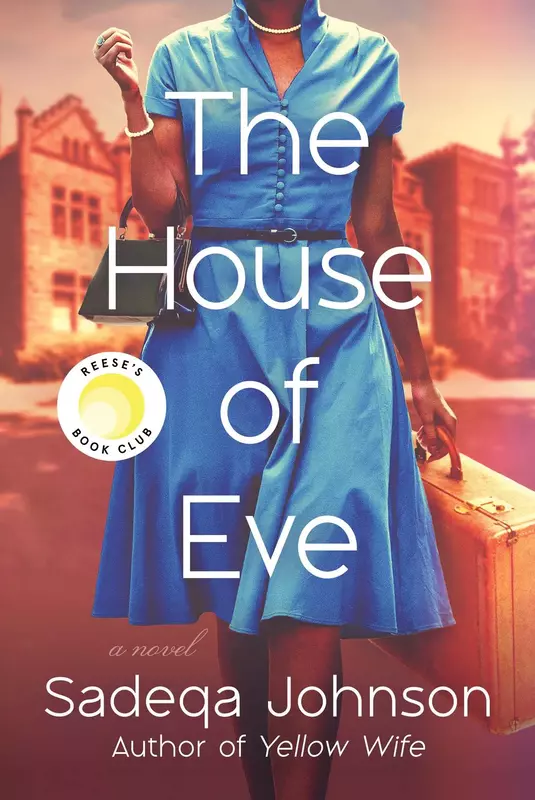This post may contain affiliate links. Read more here.

Note: the following discussion guide contains spoilers, as well as references to critical plot points and the conclusion of The House of Eve by Sadeqa Johnson.
The House of Eve, penned by Sadeqa Johnson in 2023, transports readers to the 1940s-1950s era, focusing on two central characters: Ruby Pearsall, a high school student, and Eleanor Quarles Pride, a college student.
Their stories unfold in alternating chapters, with Ruby narrating hers in the first person, while Eleanor’s is presented in third-person limited perspective. The narrative delves into themes of second chances, examining how gender, racism, and poverty intersect to influence life choices.
The House of Eve by Sadeqa Johnson

Sadeqa Johnson, an accomplished writer with an MFA who instructs in Drexel University’s MFA program, boasts a string of accolades for her fiction, including the Phyllis Wheatley Book Award, the USA Book Award for Best Fiction, and the NBCC Fiction Book of the Year Award. “The House of Eve” also earned the distinction of being chosen for the Reese Witherspoon book club.
In this guide we will go through the complete summary and ending explanation for The House of Eve by Sadeqa Johnson.
Have a wonderful book club discussion! ✨
Summary | Ending Explained | Book Club Questions
The House of Eve Summary
Set in Philadelphia in October 1948, “The House of Eve” introduces us to Ruby Pearsall, a participant in the local We Rise program. This initiative provides academic opportunities to Black students, promising scholarships to Cheyney University for those meeting its demanding criteria.
For Ruby, this program represents her ticket out of generational poverty, as she aspires to become an optometrist to aid individuals like her blind grandmother.
However, Ruby faces obstacles, particularly from her unsupportive mother, Inez, who eventually kicks her out after discovering Ruby’s innocent kiss with her boyfriend Leap, spurred by the coercion of bus fare. Seeking refuge, Ruby finds solace with her Aunt Marie.
During this tumultuous time, Ruby forms a bond with Shimmy Shapiro, a Jewish boy, and the two develop a romance. Yet, Ruby remains wary due to societal prejudice against interracial relationships.
When Ruby becomes pregnant, Shimmy proposes marriage, though his mother opposes it, leveraging Ruby’s scholarship as leverage. Reluctantly, Ruby agrees to relinquish her baby at the urging of Shimmy’s mother and enters the House of Magdalene, a facility limited to four spots for Black unwed mothers.
Meanwhile, across the East Coast, Eleanor Quarles pursues her studies at Howard University in Washington, DC. Despite hailing from humble origins, Eleanor enjoys the support of her family. Her life takes a turn when she meets William Pride, a medical student, and they fall deeply in love.
However, Rose Pride, William’s mother, disapproves of their relationship, longing for her son to wed a light-skinned woman from a wealthy background.
Their love faces further challenges when Eleanor becomes pregnant, only to endure a heartbreaking miscarriage. Despite Rose’s objections, William defies his mother’s wishes and marries Eleanor. However, tragedy strikes again when Eleanor suffers another miscarriage a year later, and medical complications arise, making future pregnancies perilous.
Undeterred by their losses, Eleanor and William decide to pursue adoption, setting their sights on a child from the House of Magdalene. Meanwhile, Ruby undergoes another ordeal, experiencing the pain of giving up her child to the same institution.
As fate intertwines their lives, Mother Margaret, overseeing the affairs, orchestrates a swap, sending Eleanor and William’s intended baby to an orphanage while inducing Ruby into premature labor to provide them with a child.
Ruby grapples with the weight of her decisions and the sacrifices made for a fleeting moment of intimacy with Shimmy. Despite his yearning for a relationship, Ruby understands the importance of prioritizing her future over fleeting desires.
Eventually, Eleanor and Rose reconcile, while Ruby confronts the reality of returning home empty-handed. However, she finds solace in her determination to pursue her dream of becoming an optometrist, marking a poignant end to her journey.
The House of Eve Ending Explained
So, what happens at the end of The House of Eve?
Towards the conclusion of the novel, the chapters become notably shorter compared to the earlier ones. This shift serves multiple purposes. Firstly, it reflects the characters’ immediate experiences, focusing on the present moment rather than delving into extensive backstories or flashbacks. For instance, Ruby grapples with the trauma of a coerced childbirth under heavy sedation, while Eleanor and William anxiously anticipate the arrival of their promised child.
Throughout the narrative, Ruby has endured various forms of violation, from the leering gaze of predatory men on the streets to the sexual assault by Leap. Now, she finds herself rendered unconscious as medical professionals forcibly deliver her baby without her consent, further emphasizing her loss of agency.
The symbolism of the green blanket enveloping Ruby’s baby underscores the pervasive influence of the white-dominated society she despises. Despite her anger towards Shimmy, his mother, and the white medical staff, Ruby finds solace in her profound love for her half-white baby, Grace (Wilhelmina).
The narrative also underscores the enduring strength of maternal bonds through Ruby’s actions and reflections post-birth. Despite Inez’s lifelong rejection, Ruby yearns for her mother’s presence after the delivery. Despite having supportive figures like Aunt Marie and Grandma Nene, Ruby’s bond with Inez remains unbreakable, illustrating the complex dynamics of maternal relationships, for better or worse.
Diving deeper into the theme of motherhood, some Christian beliefs link Eve and Mary. Eve’s act of eating from the forbidden tree led to humanity’s downfall, while Mary giving birth to Jesus brings hope for redemption. Both figures are tied to the story of the House of Magdalene.
Eleanor, seeing Eve as the symbolic mother of all despite her negative image, calls the place the House of Eve. When a Black girl named Mary arrives, destined for a similar fate as others, it shows how both Eve and Mary share in the pain of motherhood, despite their different reputations.
Rose, overseeing Eleanor and William’s adoption, connects Wilhelmina’s green eyes to their family history, creating a barrier that separates Eleanor from fully belonging to the Prides’ world. But eventually, Rose reveals her own white ancestry to Eleanor, bridging their divide. Wilhelmina’s connection to the white world through her father Shimmy is born out of love, unlike the Prides’ history of ties to whiteness through sexual assault.
Ruby’s decision to break ties with Shimmy shows the sacrifices she’s willing to make to break free from poverty, even giving up loved ones like Shimmy and Grace (Wilhelmina). Though she achieves her dream of becoming an optometrist, Eleanor notices that Ruby’s smile doesn’t reach her eyes, hinting at lingering regrets or the weight of her past.
Before moving forward, Ruby finds some peace with her mother, Inez, who tries to be a better mother to her new baby, Lena, unlike her treatment of Ruby. Inez’s reliance on men for stability contrasts with Ruby’s pursuit of education for independence. Despite Inez’s faults, her decision to entrust Ruby’s care to loving family members shows their shared struggle as Black women in a harsh world.
Receiving her scholarship to Cheyney University leaves Ruby feeling numb, her journey marked by pregnancy, forced delivery, and the pain of giving up her daughter. The scholarship, earned through sacrifice, leaves her wondering what might have been as she looks at her daughter’s painting with mixed emotions at the story’s end.
How did you like the ending of the novel? Happy reading! ❤️